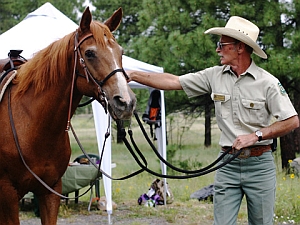The Australian division of Pfizer Animal Health in Brisbane released today a new vaccine to prevent disease from the Hendra virus that can be fatal to horses and humans. Pfizer’s Equivac HeV is the product of research conducted at Uniformed Services University of the Health Sciences (USU) and licensed from the Henry M. Jackson Foundation for the Advancement of Military Medicine.
Hendra virus is an emerging zoonotic virus — one that is transmitted to humans from animals — that can cause respiratory and neurological disease in horses, with the potential for transmission to humans. The virus was first identified in 1994 during an outbreak of acute respiratory disease among 21 horses in Australia. From that outbreak, two people were infected, and one died. Hendra virus has claimed the lives of more than 60 horses, including nine deaths in 2012 alone.
A related zoonotic virus is the Nipah virus that causes severe illness characterized by encephalitis — inflammation of the brain — or respiratory diseases. The Hendra and Nipah viruses are transmitted from bat-like animals called flying foxes or fruit bats that caused cause serious disease outbreaks in humans and livestock in Australia, Bangladesh, India, Malaysia, and Singapore. Recent Nipah outbreaks have been characterized by person-to-person transmission, and greater than 75 percent case fatality rates among humans.
The Pfizer vaccine is derived from research by Christopher Broder, director of USU’s infectious disease program, and Katharine Bossart, a USU alumna and professor at Boston University’s medical school. An equine vaccine blocks the development of disease and transmission of the virus to horses, and thus breaks the Hendra virus transmission cycle from flying foxes to horses and then to people. Tests of the vacine show vaccinated horses survive infection by Hendra virus and show no evidence of virus, disease, replication or shedding of the virus.
“The vaccine component is a soluble portion of a Hendra virus G glycoprotein, known as Hendra-sG,” says Broder. “It is this glycoprotein that mediates viral infection. If you block its function, you block virus infection.” Broder adds that “Studies with Hendra-sG glycoprotein have shown promise in helping to prevent infection by its close relative, Nipah virus.” The National Institute of Allergy and Infectious Disease, part of National Institutes of Health, supported Broder’s and Bossart’s work.
Pfizer Animal Health developed Equivac HeV in collaboration with Australian Animal Health Laboratory, a division of Australia’s national science agency, the Commonwealth Scientific and Industrial Research Organisation (CSIRO). Much of the work was conducted in the lab’s biosecure facilities under the direction of veterinary pathologist Deborah Middleton. Because of the deadly threat of the disease, Pfizer and CSIRO accelerated the vaccine’s development and regulatory approvals, reducing the time for the process to about two years.
“As a veterinarian, I have seen firsthand how Hendra virus has created difficult working conditions for my colleagues and any Australian who works with horses,” says Middleton. “For the first time, we have a Hendra virus specific tool that provides vets with a greater level of safety when they come into contact with sick horses.”
Read more:
- Bayer CropScience, Australian Agencies Partner on Wheat R&D
- GE Healthcare, CSIRO to Partner on Alzheimer’s Diagnostics
- Australian Science Agency, Biotech Partner on Insect Silks
- Australian Researchers Develop Salt-Tolerant Wheat Strain
* * *


 RSS - Posts
RSS - Posts
[…] Pfizer Develops Equine Vaccine from University Research […]
[…] Pfizer Develops Equine Vaccine from University Research […]